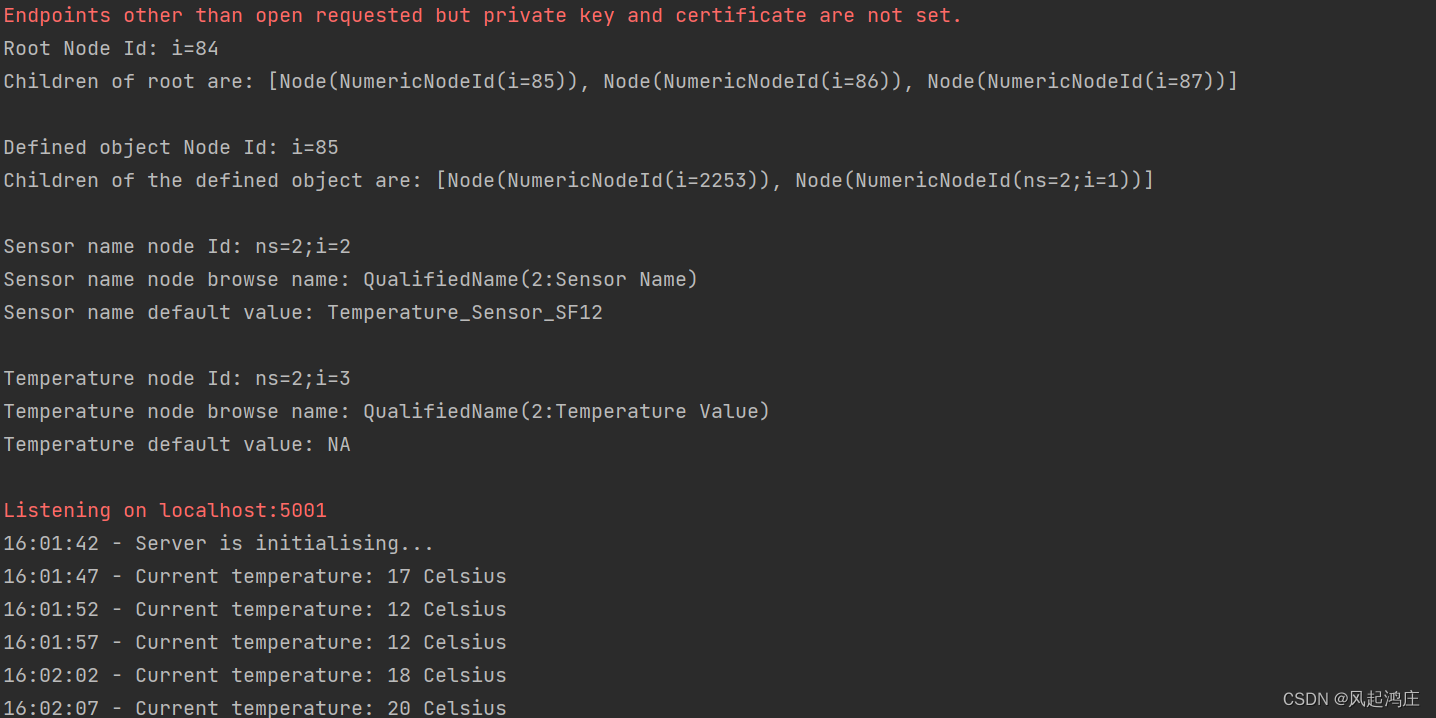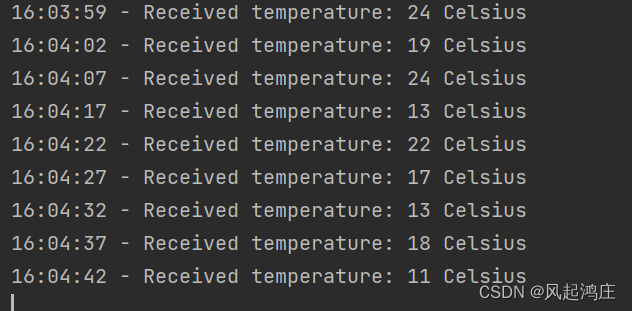前言
之所以一直没写博文,大概是一直比较忙。
接了一些额外的活,做了几个视频放到了其他平台上,也通过做工程训练的车弥补了自己51和stm32,esp,还有定时器,i2c总线复用等等的知识,虽然工训是延期了,不过假期还是要继续做车,相关的博文也是要补上的
最近其实也系统的学了一下机器学习和深度学习的知识,写出了一篇应用在嵌入式设备上的深度学习目标检测论文,之后也会总结相关的知识,并尽量通俗易懂的解释出来。
那就先从opcua开始吧~~~
OPCUA通信协议介绍
OPC UA(OPC 统一架构)是一种用于工业控制系统的通信协议。它是一种开放的、平台无关的协议,可用于连接各种工业设备和软件应用程序,使它们能够互相通信并共享数据。
OPC UA 的主要优点在于,它能够提供一种统一的方式来连接不同厂商的设备和应用程序。这意味着,使用 OPC UA 的软件应用程序可以与使用其他协议的设备和应用程序进行通信,而无需考虑底层的通信协议。
其实这类似于物联网中的mqtt协议,只不过mqtt较为轻量级,opcua则是用于工业相关的控制系统
OPCUA的两种工作方式
-
客户端/服务器模式:在这种模式下,OPC UA 客户端向 OPC UA 服务器请求数据,服务器接收请求并向客户端发送数据。
-
发布/订阅模式:在这种模式下,OPC UA 服务器将数据“发布”到网络上,而客户端可以“订阅”特定的数据。当服务器更新数据时,客户端会收到更新的数据。
这两种模式可以根据应用场景的需要进行选择。例如,客户端/服务器模式适用于客户端需要向服务器请求单个数据项的情况,而发布/订阅模式则适用于客户端需要定期接收大量数据的情况。
个人觉得客户端/服务器模式类似于TCP通讯协议,是点对点的,对实时性要求比较高,而发布订阅模式类似于UDP通讯协议,对实时性要求并没有那么高,但接收数据较多
其中发布订阅模式对小的嵌入式设备(stm32系列)比较友好,可以融合物联网的mqtt协议,真正将opcua纳入网络,而不只是自己的工业网络
OPCUA-python是什么?
顾名思义,那就是利用python实现这种通信协议的库呗,这个库目前已经停止更新,开发者们开发了一个新的库,名为opcua-asyncio,可通过如下链接访问:
https://github.com/FreeOpcUa/opcua-asyncio
不过做一些比较基本的功能,只用OPCUA-python这个库还是够用的
服务器常用函数
endpoint = "opc.tcp://{}:{}".format(url, port) myserver.set_endpoint(endpoint)设置endpoint(其实endpoint就像一个服务器链接)
myserver = opcua.Server()开启opcua服务器
objects = myserver.get_objects_node()设置服务器节点(使客户端得以访问)
addspace = myserver.register_namespace(name)设置服务器命名空间
root = myserver.get_root_node()获取服务器根节点
objects.add_method(1, "Conveyor", Start_Conveyor_prog)为节点(objects) 添加方法Start_Conveyor_prog
客户端常用函数
myclient = Client(endpoint)在客户端引用endpoint
myclient.get_node("ns=2;i=3")在客户端里使用ns=2;i=3这个节点
Start_Lathe_Prog1 = method[4]调用服务器里设置的方法
Workpiece = objects_node.call_method(Start_Conveyor_prog,[WorkpieceID.get_value()])call_method函数,第一个参数是节点名称,第二个参数是值,是这个节点里的值,属于数组,或者传递字典也是可以的
return_value_kuka_prog1 = objects_node.call_method(Start_Kuka_Prog1)返回某个方法
示例程序:温度实时检测,每隔五秒传到客户端
服务器程序:
import opcua
from time import sleep
from random import randint
from datetime import datetime
# Assign endpoint URL
url = "localhost"
port = 5001
endpoint = "opc.tcp://{}:{}".format(url, port)
# create instance/object of type opcua.Server
myserver = opcua.Server()
# Assign endpoint url on the OPC UA server address space
myserver.set_endpoint(endpoint)
# Create a name for OPC UA namespace
name = "Temperature Sensor"
# Register the name on OPC UA namespace
addspace = myserver.register_namespace(name)
# Get reference to the Objects node of the OPC UA server
objects = myserver.get_objects_node()
# Create objects on the object node
param = objects.add_object(addspace, "parameters")
# Create variables
Sensor_name = param.add_variable(addspace, "Sensor Name", "Temperature_Sensor_SF12")
Temperature = param.add_variable(addspace, "Temperature Value", 'NA')
# Set variable as writable
Sensor_name.set_writable()
Temperature.set_writable()
#########################################################################################
# Present the data structure of the OPC UA server
root = myserver.get_root_node()
print("Root Node Id: %s" % root)
print("Children of root are: %s" % root.get_children())
print()
my_objects = myserver.get_objects_node()
print("Defined object Node Id: %s" % my_objects)
print("Children of the defined object are: %s" % my_objects.get_children())
print()
sensor_name_node = my_objects.get_children()[1].get_children()[0]
print("Sensor name node Id: %s" % sensor_name_node)
print("Sensor name node browse name: %s" % sensor_name_node.get_browse_name())
print("Sensor name default value: %s" % sensor_name_node.get_value())
print()
temperature_node = my_objects.get_children()[1].get_children()[1]
print("Temperature node Id: %s" % temperature_node)
print("Temperature node browse name: %s" % temperature_node.get_browse_name())
print("Temperature default value: %s" % temperature_node.get_value())
print()
########################################################################################
# starting! The server will continue running
myserver.start()
current_time = str(datetime.now().time())[:-7]
print("{} - Server is initialising...".format(current_time))
while True:
sleep(5)
current_time = str(datetime.now().time())[:-7]
current_temp = randint(10, 25)
Temperature.set_value(current_temp) # publish temperature value
print("{} - Current temperature: {} Celsius".format(current_time, current_temp))客户端程序:
from opcua import Client
from datetime import datetime
# Assign endpoint URL
url = "localhost"
port = 5001
endpoint = "opc.tcp://{}:{}".format(url, port)
# Assign endpoint url on the OPC UA client address space
myclient = Client(endpoint)
# Connect to server
myclient.connect()
# Assign nodes
Temperature_node = myclient.get_node("ns=2;i=3")
# Subhandler Class from OPC UA
class SubHandler(object):
"""
Subscription Handler. To receive events from server for a subscription
"""
def datachange_notification(self, node, val, data):
"""
called for every datachange notification from server
"""
global DataChange # Global variable
current_time = str(datetime.now().time())[:-7]
DataChange = val # Assigning value to global variable
print("{} - Received temperature: {} Celsius".format(current_time, val))
# Initailise variable
nodes = myclient.get_objects_node()
DataChange = "null"
# Create Sub handler
handler = SubHandler()
# create subscription by passing period in milliseconds and handler
subscribe = myclient.create_subscription(0, handler)
# pass variable node to subscribe data change method
handler = subscribe.subscribe_data_change(Temperature_node)
程序运行效果:服务器

程序运行效果:客户端

最后
以上就是忧伤钢笔最近收集整理的关于opcua-python学习踩坑总结前言OPCUA通信协议介绍OPCUA的两种工作方式OPCUA-python是什么?服务器常用函数客户端常用函数 示例程序:温度实时检测,每隔五秒传到客户端的全部内容,更多相关opcua-python学习踩坑总结前言OPCUA通信协议介绍OPCUA内容请搜索靠谱客的其他文章。








发表评论 取消回复